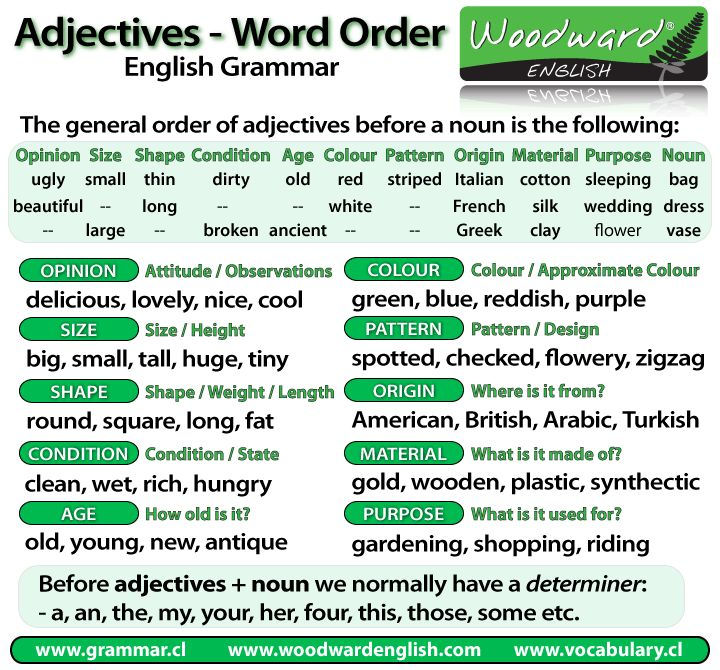English is a strange language. A case in point can be made with these two similar sentences:
Could you please let me know where I can find the book? Please let me know where I can find the book.
Try explaining to someone who is not a native speaker the difference between the two written sentences above. The difference is not that one is a question and the other is a statement, because they are both asking for the same thing. The difference is the tone. And that difference in English composition is often embedded in word order, the way the words are arranged in the sentence.
Word order in English is important, because it can change the spirit, meaning or fluency of a sentence. Basically, it’s considered an SVO language, like such Romance languages as Spanish, French, Italian and Romanian, meaning that generally sentences follow the Subject-Verb-Object pattern. But it’s more complicated than that when subtleties need to be expressed or when descriptions need to be detailed.
Regarding spirit or tone: the first sentence in our example, worded as a question, could easily be interpreted by someone reading it in an email, for example, as being asked with irritation. Same with this example, “Can you please amend the deadline?” It sounds like the person asking the question is stressed and really needs for the deadline to be changed. But that’s not the case with the statement, “Please amend the deadline.” No irritation is transmitted by this wording. Placing “Please” at the beginning of the sentence makes all the difference in terms of tone and comprehension.
Now consider the following two sentences:
He genuinely needs to do that. He needs to do that genuinely.
They use the same words, but they differ in meaning. The first signifies that the person really needs to do something, while the second means that the person must do something honestly or with sincerity. The word order is important here not to convey feeling or tone, but to impart a particular sense or interpretation.
Another consideration regarding the order of words concerns fluency or accuracy. The placing of adjectives is particularly problematic in English for those learning the language. Native speakers learn the order as if by osmosis, and many don’t even realize there is a particular sequence. They just know where the words need to go depending on what they want to communicate.
Perhaps this list will help students of English place adjectives in the correct order. Found on the internet, this information was posted by a teacher at a school in California, USA back in 2009:
The proper order of adjectives is listed below along with some examples for each category.
1. Determiners – a, an, the, my, your, several, etc.
2. Observations – lovely, boring, stimulating, etc.
3. Size – tiny, small, huge, etc.
4. Shape – round, square, rectangular, etc.
5. Age – old, new, ancient, etc.
6. Color – red, blue, green, etc.
7. Origin – British, American, Mexican, etc.
8. Material – gold, copper, silk, etc.
9. Qualifier – limiters for compound nouns.
Here are some examples (by Thomas Williams, teacher at EC San Diego English School):
“The interesting, small, rectangular, blue car is parked in my space.”
“I bought a beautiful, long, red, Italian, silk tie.”
“My father lives in a lovely, gigantic, ancient, brick house.”
“I have an annoying, small, circular, American, tin, alarm clock that wakes me up.”
“Let’s order a delicious, huge, rectangular, pepperoni pizza.”
“We all love our smart, petite, British teacher.”
“They all received several dazzling, small, ancient, gold coins.”
“She owns a stunning, large, old, brown dog named Boris.”
The following chart is also helpful. If you have trouble learning it by heart, then keep it handy!

Source: Adjectives-word-order by attanatta
Also on the point of accuracy or fluency, written as well as spoken English uses many compound verbs, which are multi-word groups that act as a single verb. Examples include to “give up” (to “abandon”; “cease making an effort; admit defeat”) or to “give for” (to “offer”) and to “look up” (to “search”; “improve”). The separate words making up the verb must be placed in the sentence correctly. It’s accurate to write, for instance, “I gave her a sweater for her birthday”, but not, “I gave her for her birthday a sweater”. Another fluent sentence is, “I looked the word up in the dictionary”, and not “I looked up the word in the dictionary”, although the latter is often used.
Idioms, those word groups that have particular meaning not deducible from the individual words, also have a particular word order in English. Take, for example, this one: “to check at the door”, which means “to get rid of before entering someplace”. Correct usage is “to check something at the door”, such as, “to check your attitude at the door”. It would not be correct to write, “She checked at the door her attitude.”
The order of wording of compound verbs and idioms ties back to the usual Subject-Verb-Object construction of the English tongue, with added complexity. The object in the last sample sentence is the something, i.e. the “attitude”, so it has a specific place in the phrase. And where is that? Referring back to our examples above, a simple way to remember what’s proper is to substitute the word “it” for the thing/object. So: “she checked it at the door”, not “she checked at the door it”; “to give it for a birthday”, not “to give for a birthday it”; and “to look it up”, not “to look up it”.
But English, as all languages, changes with time. Few stop to think about the proper placement of words in a sentence when they write, although doing so would improve clarity and ensure the right message is getting across. With lackadaisical use over time, however, the nuances of meaning may decline and with them precision as well as full knowledge and understanding.

